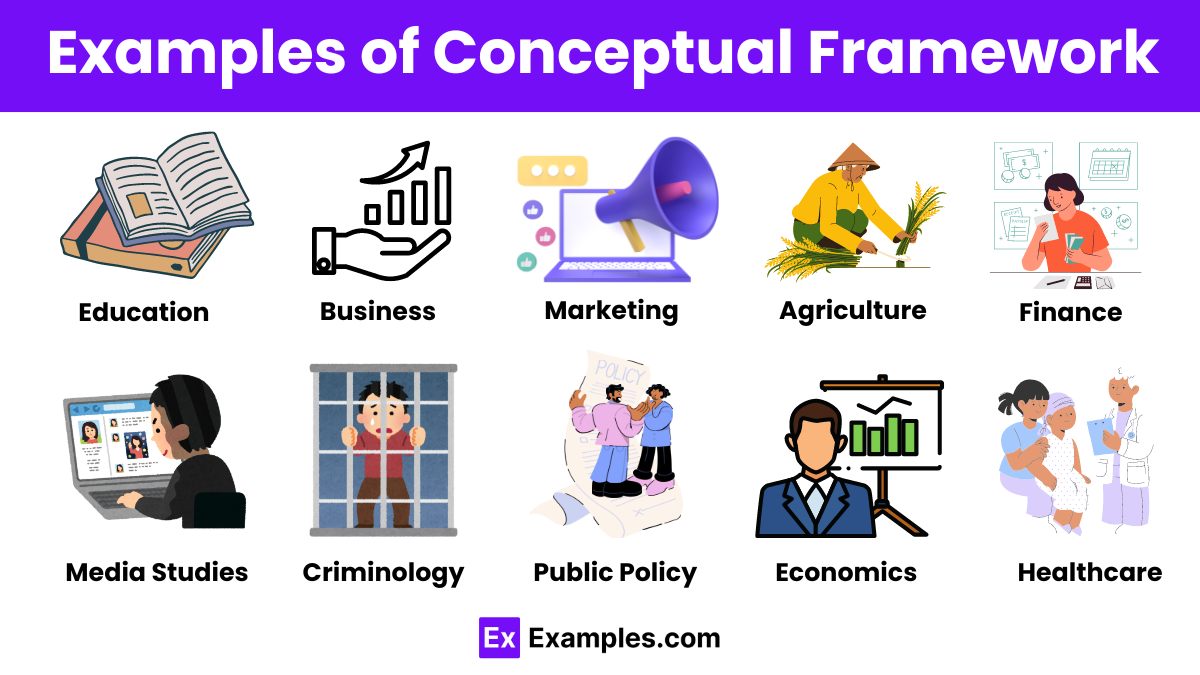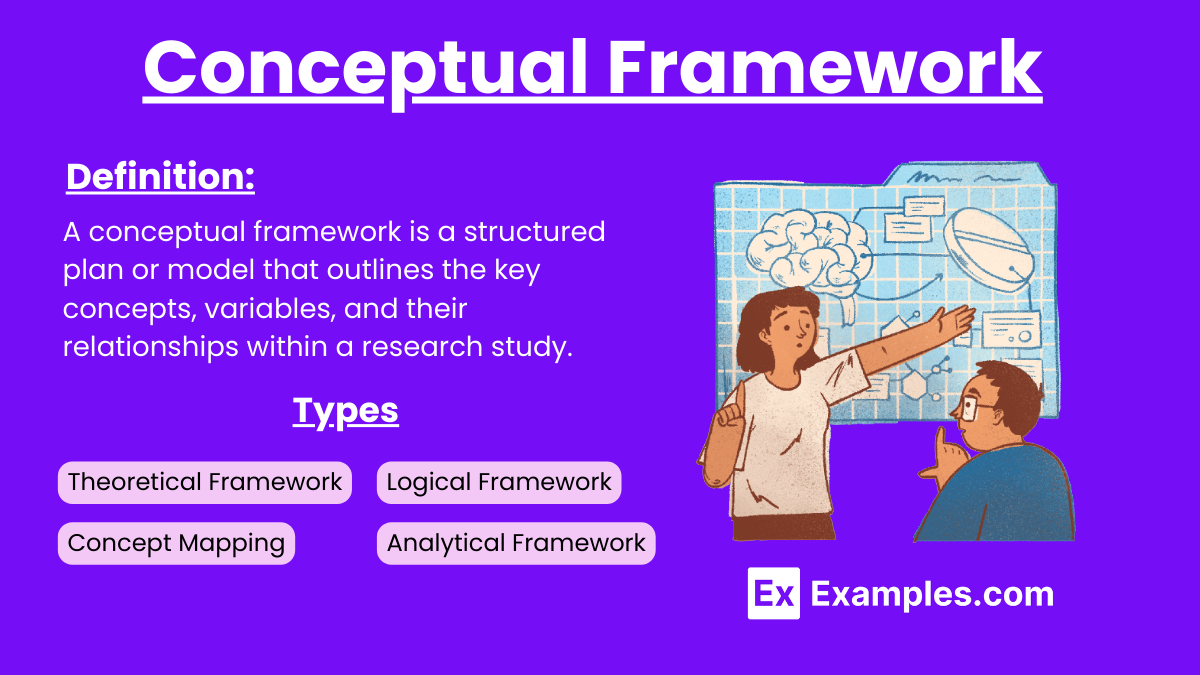20+ Conceptual Framework Examples to Download
A Conceptual Framework is a structured approach that guides research by outlining key concepts, variables, and their relationships. It integrates relevant Theoretical Frameworks, which are established theories used to support the study’s foundation. Through Conceptual Analogy, complex ideas are simplified and made relatable. In a Thesis Paper, the conceptual framework clarifies the research direction and underpins the study’s methodology.
What is Conceptual Framework?
A Conceptual Framework is a system of concepts, assumptions, expectations, beliefs, and theories that supports and informs research. In a dissertation, it helps structure and guide the study, while in a business model, it outlines the components and relationships essential for business success.
Examples of Conceptual Framework

- Education: A framework linking student engagement, teaching strategies, and academic achievement.
- Healthcare: A model connecting patient satisfaction, healthcare quality, and treatment outcomes.
- Psychology: A structure relating cognitive behavioral therapy, mental health improvement, and patient adherence.
- Business: A framework integrating innovation, market competitiveness, and financial performance.
- Marketing: A model connecting consumer behavior, advertising strategies, and brand loyalty.
- Environmental Science: A structure relating human activity, pollution levels, and ecosystem health.
- Sociology: A framework linking social inequality, access to resources, and community wellbeing.
- Economics: A model connecting fiscal policy, economic growth, and employment rates.
- Technology: A framework integrating technological adoption, user experience, and system efficiency.
- Public Policy: A structure relating policy interventions, public response, and societal impact.
- Human Resources: A model linking employee training, job satisfaction, and organizational productivity.
- Agriculture: A framework connecting farming practices, crop yields, and food security.
- Urban Planning: A structure relating urban design, community development, and sustainability.
- Finance: A model integrating investment strategies, market risk, and portfolio performance.
- Education Administration: A framework linking leadership styles, school culture, and student outcomes.
- Tourism: A model connecting tourist satisfaction, destination marketing, and economic benefits.
- Sports Science: A framework relating training methods, athlete performance, and injury prevention.
- Criminology: A structure connecting crime prevention strategies, law enforcement practices, and crime rates.
- Information Systems: A model linking data management, information flow, and organizational decision-making.
- Media Studies: A framework integrating media content, audience perception, and societal influence.
Types of Conceptual Framework
Theoretical Framework
This type of framework draws on existing theories and models to frame a study’s methodology, design, and analysis. It helps researchers link their findings to broader theoretical systems.
Concept Mapping
This involves visual representations of concepts and their relationships within a topic. Concept maps are used to organize and structure knowledge and can be a helpful tool in educational and learning environments.
Logical Framework
Often used in project management, this framework helps in planning and implementing projects by setting objectives, identifying resources, and outlining activities and timelines. It helps stakeholders understand the project’s structure and goals.
Analytical Framework
This framework is used to systematically analyze qualitative data by identifying patterns, themes, and relationships. It is crucial in research areas like sociology, anthropology, and psychology.
The importance of a conceptual framework
1. Clarifies Research Focus
A conceptual framework helps to define the scope and focus of a study. It identifies key variables and their relationships, guiding the research process and ensuring that the study remains focused on relevant questions.
2. Enhances Understanding
By visually and theoretically mapping out the connections between concepts, a conceptual framework aids in understanding complex issues. It simplifies intricate relationships, making it easier for researchers, stakeholders, and readers to grasp the study’s core ideas.
3. Guides Methodology
The framework informs the research design and methodology. It helps in selecting appropriate research methods, data collection techniques, and analytical strategies, ensuring that the research approach aligns with the study’s objectives.
4. Supports Theory Development
A conceptual framework provides a structured basis for theory development. It integrates existing theories and empirical findings, allowing researchers to build on previous knowledge and contribute to the advancement of their field.
5. Facilitates Communication
For dissertations, business models, or any research project, a conceptual framework serves as a communication tool. It clearly presents the study’s foundation, assumptions, and hypotheses, making it easier to explain and justify the research to peers, advisors, and stakeholders.
6. Assists in Identifying Gaps
The framework helps identify gaps in the current literature and areas needing further exploration. This can guide future research and help prioritize areas for investigation, ensuring that the study adds value to the existing body of knowledge.
Steps to Develop a Conceptual Framework
1. Identify the Research Problem
Start by clearly defining the research problem or question. Understand what you aim to explore, explain, or predict. This step sets the foundation for your entire framework.
2. Conduct a Literature Review
Review existing literature related to your research problem. Identify key theories, concepts, and empirical findings that are relevant to your study. This helps you understand the current state of knowledge and identify gaps.
3. Select Key Variables
From the literature review, identify the key variables that are central to your research problem. These could be dependent, independent, or intervening variables. Clearly define each variable and its role in your study.
4. Formulate Hypotheses
Based on the identified variables, develop hypotheses or research questions that your study will address. These should specify the expected relationships between the variables.
5. Create Conceptual Diagrams
Visually represent the relationships between the variables in the form of diagrams or models. This helps in understanding and communicating the framework more effectively. Use arrows to show causal relationships and interactions between variables.
6. Integrate Theoretical Frameworks
Incorporate relevant theoretical frameworks that support your conceptual model. Theoretical frameworks provide a foundation for your hypotheses and help explain why and how the variables are related.
7. Refine the Framework
Review and refine your conceptual framework to ensure clarity and coherence. Ensure that all components are logically connected and that the framework addresses the research problem comprehensively.
8. Validate the Framework
Seek feedback from peers, advisors, or experts in the field to validate your conceptual framework. Make necessary adjustments based on their suggestions to strengthen your model.
9. Apply the Framework
Use the conceptual framework to guide your research design and methodology. It should inform your data collection, analysis, and interpretation processes, ensuring alignment with your research objectives.
10. Document and Present
Clearly document your conceptual framework in your research proposal, thesis, or dissertation. Present it using diagrams and detailed explanations to ensure that readers understand its components and significance.
Theoretical Framework vs Conceptual Framework
- Theoretical Framework: A theoretical framework is a structure of theories that guides research by explaining why and how certain phenomena occur. It is rooted in established theories and provides a foundation for understanding the study.
- Purpose: To support the study with existing theories and offer a basis for developing hypotheses.
- Components: Includes specific theories, models, and constructs relevant to the research problem.
- Example: In studying the impact of integrated marketing on consumer behavior, the theoretical framework might include theories like the Theory of Planned Behavior or the Elaboration Likelihood Model.
- Conceptual Framework: A conceptual framework is a system of concepts, assumptions, expectations, beliefs, and theories that supports and informs research. It provides a broader perspective and outlines the relationships between key concepts.
- Purpose: To define the research problem, identify key variables, and illustrate their relationships.
- Components: Includes key variables, concepts, and the presumed relationships between them.
- Example: For a study on the impact of integrated marketing on consumer behavior, the conceptual framework might include variables like marketing channels, consumer attitudes, purchase intentions, and brand loyalty.
Examples in Context
Impact of Integrated Marketing on Consumer Behavior:
- Theoretical Framework: The study might draw on the Theory of Planned Behavior to explain how integrated marketing strategies influence consumer attitudes, which in turn affect purchase intentions and behaviors.
- Conceptual Framework: It could illustrate how various marketing channels (social media, TV, print) interact to shape consumer perceptions, attitudes, and behaviors, highlighting the relationships between these variables.
Advertising and Marketing Business Plan:
- Theoretical Framework: The plan could incorporate the AIDA model (Attention, Interest, Desire, Action) to explain the stages of consumer engagement.
- Conceptual Framework: It might depict the relationship between marketing tactics (advertising, promotions, public relations) and business outcomes (sales growth, brand awareness, market penetration).
Interaction Model of Communication:
- Theoretical Framework: This might involve the Shannon-Weaver Model, which explains communication as a process involving a sender, message, medium, receiver, and feedback.
- Conceptual Framework: It could show how different communication components (message clarity, medium effectiveness, feedback mechanisms) interact to affect communication outcomes in various contexts.
Photo Essay:
- Theoretical Framework: In a photo essay, a theoretical framework might draw on visual rhetoric theory to explain how images convey messages and evoke emotions.
- Conceptual Framework: It could illustrate the relationship between visual elements (composition, lighting, subject matter) and the narrative or thematic impact of the photo essay.
Comparison Table
| Aspect | Theoretical Framework | Conceptual Framework |
|---|---|---|
| Definition | Structure of theories explaining phenomena | System of concepts and theories supporting research |
| Purpose | Support study with existing theories, develop hypotheses | Define problem, identify variables, illustrate relationships |
| Components | Theories, models, constructs | Key variables, concepts, relationships |
| Example (Marketing) | Theory of Planned Behavior, Elaboration Likelihood Model | Marketing channels, consumer attitudes, brand loyalty |
Tips for Developing a Conceptual Framework
- Clearly Define the Research Problem
- Conduct a Thorough Literature Review
- Identify Key Variables
- Establish Relationships Between Variables
- Use Visual Diagrams
- Integrate Relevant Theories
- Refine Your Framework
- Ensure Alignment with Research Goals
- Document and Explain
- Be Flexible
What is a conceptual framework?
A conceptual framework organizes key concepts and relationships, guiding research by defining variables and their interactions.
Why is a conceptual framework important?
It clarifies research focus, guides methodology, and enhances understanding by mapping out complex relationships between variables.
How do you develop a conceptual framework?
Identify the research problem, conduct a literature review, select key variables, establish relationships, and create visual diagrams.
What is the difference between a theoretical and a conceptual framework?
Theoretical frameworks use established theories to explain phenomena; conceptual frameworks map out key concepts and their relationships.
Can a conceptual framework evolve during research?
Yes, it can be refined as new insights and data are gathered, ensuring it remains relevant and accurate.
What are the key components of a conceptual framework?
Key components include variables, concepts, assumptions, and the relationships between them.
How does a conceptual framework aid in hypothesis formulation?
It helps identify and define key variables, facilitating the development of clear, testable hypotheses.
Can a conceptual framework be used in business plans?
Yes, it outlines the relationships between business components, aiding in strategy development and decision-making.
How is a conceptual framework presented in research?
It is documented with visual diagrams and detailed explanations, ensuring clarity and coherence in the study.
What role does a literature review play in developing a conceptual framework?
A literature review identifies relevant theories, concepts, and gaps, providing a foundation for the framework.


